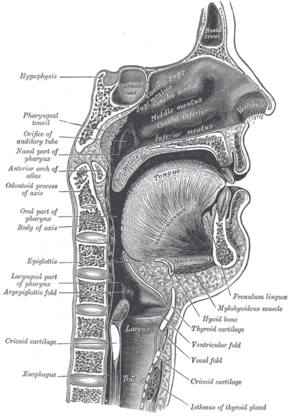Medicine:Prevertebral space
| Prevertebral space | |
|---|---|
 Section of the neck at about the level of the sixth cervical vertebra. Showing the arrangement of the fascia coli. | |
 Sagittal section of nose mouth, pharynx, and larynx. | |
| Anatomical terminology |
The prevertebral space is a space in the neck.
On one side it is bounded by the prevertebral fascia.[1]
On the other side, some sources define it as bounded by the vertebral bodies,[2] and others define it as bounded by the longus colli.[1]
It includes the prevertebral muscles (longus colli and longus capitis), vertebral artery, vertebral vein, scalene muscles, phrenic nerve and part of the brachial plexus.[3]
In trauma, an increased thickness of the prevertebral space is a sign of injury, and can be measured with medical imaging.[4]
Clinical significance
On plain radiography, prevertebral space should be less than 6 mm at C3 vertebral level in children; while in adults, the space should be less than 6 mm at C2 level and less than 22 mm at C6 level. Causes of enlarged prevertebral space could be edema, hematoma, abscess, tumors, and post surgical changes.[5]
References
- ↑ 1.0 1.1 "eMedicine - Retropharyngeal Abscess : Article by Todd J Berger, MD". http://www.emedicine.com/ped/topic2682.htm#section~introduction.
- ↑ "Deep Neck Space Infections: Changing Trends". http://www.bcm.edu/oto/grand/10694.html.
- ↑ "Prevertebral space cervical". Medcyclopaedia. GE. http://www.medcyclopaedia.com/library/topics/volume_vi_2/p/prevertebral_space_cervical.aspx.[|permanent dead link|dead link}}]
- ↑ 4.0 4.1 Rojas, C.A.; Vermess, D.; Bertozzi, J.C.; Whitlow, J.; Guidi, C.; Martinez, C.R. (2009). "Normal Thickness and Appearance of the Prevertebral Soft Tissues on Multidetector CT". American Journal of Neuroradiology 30 (1): 136–141. doi:10.3174/ajnr.A1307. ISSN 0195-6108.
- ↑ "Retropharyngeal and prevertebral spaces: anatomic imaging and diagnosis". Otolaryngologic Clinics of North America 45 (6): 1293–310. December 2012. doi:10.1016/j.otc.2012.08.004. PMID 23153750.
 |
![CT scan with upper limits of the thickness of the prevertebral space at different levels.[4]](/wiki/images/thumb/d/d2/CT_of_prevertebral_space.jpg/151px-CT_of_prevertebral_space.jpg)

